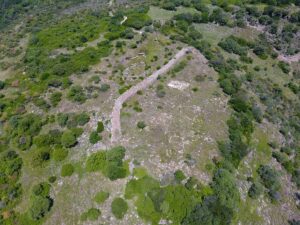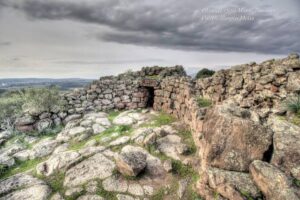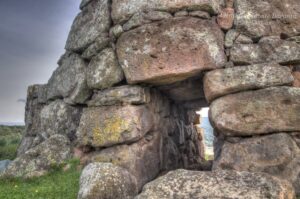Giovanni Ugas writes in his book “The Dawn of the Nuraghi”:
<<…Series of containers, often found intact, small cups and bowls containing liquids, attest to rituals practiced from the Middle Bronze Age to the Recent Bronze Age, within the megalithic enclosure shaped like an arch or a horseshoe, defined as the tower-enclosure, of Monte Baranta-Olmedo… the arched wall, which has two entrances, one facing West and the other North, carves and separates like a “temenos” (a wall that delineates a sacred area n.d.r.) a space around a precipice. The very presence of the precipice allows us to grasp the precise sacred nature of the area “cut” by the megalithic curved nuragic enclosure of Monte Baranta, already indicated by elements of material culture. Small cups and truncated conical bowls designed to hold liquids, with a well-developed handle to facilitate gripping, found in large numbers intact or nearly so and thus deposited and abandoned, are concentrated in the corridor of the West entrance of the enclosure, which means that the offering ritual took place precisely “neither inside nor outside,”
The very presence of the precipice allows us to grasp the precise sacred nature of the area “cut” by the megalithic curved nuragic enclosure of Monte Baranta, already indicated by elements of material culture. Small cups and truncated conical bowls designed to hold liquids, with a well-developed handle to facilitate gripping, found in large numbers intact or nearly so and thus deposited and abandoned, are concentrated in the corridor of the West entrance of the enclosure, which means that the offering ritual took place precisely “neither inside nor outside,” as is fitting for a space of meeting and separation between two worlds. The courtyard space delimited by the “temenos” was a prohibited place, except for the one who offered and the one who received the sacrificial drink.
as is fitting for a space of meeting and separation between two worlds. The courtyard space delimited by the “temenos” was a prohibited place, except for the one who offered and the one who received the sacrificial drink.
Everything points to the idea that at the West entrance (facing the world without light) and in the courtyard the sacrificial act of the elders was consumed, having fallen into the abyss from the top of the cliff, perhaps after being poisoned with hemlock, the drink that caused the “sardonic laugh,” contained within the cups. From the courtyard, the world of darkness, cut off by the fence symbolizing the boundary of time and light, the old father, once entered, would no longer come out. The accompanying son could re-enter through the other entrance, which from the North-East led to the light, to be reborn in the new guise of heir, perhaps again the head of the community.
From the courtyard, the world of darkness, cut off by the fence symbolizing the boundary of time and light, the old father, once entered, would no longer come out. The accompanying son could re-enter through the other entrance, which from the North-East led to the light, to be reborn in the new guise of heir, perhaps again the head of the community.
The theme of euthanasia connected to the “sardonic laugh” was previously addressed by Raffaele Pettazzoni, the foremost historian of religions, who in 1912 wrote in his book “La Religione primitiva in Sardegna”: <<…Among the Sardinians, the elderly who had passed seventy were killed by their own children, who, armed with rods and sticks, brutally beat them and pushed them to the edge of deep pits like abysses, making them die; and they accompanied this cruel operation with inhumane laughter. This is told to us by Elian, by Demon, and by others; and it seems to date back, recently, to Timeus>>.
<<…Among the Sardinians, the elderly who had passed seventy were killed by their own children, who, armed with rods and sticks, brutally beat them and pushed them to the edge of deep pits like abysses, making them die; and they accompanied this cruel operation with inhumane laughter. This is told to us by Elian, by Demon, and by others; and it seems to date back, recently, to Timeus>>.
The photos of the megalithic complex of Monte Baranta in Olmedo are by Sergio Melis and Antonello Gregorini.

